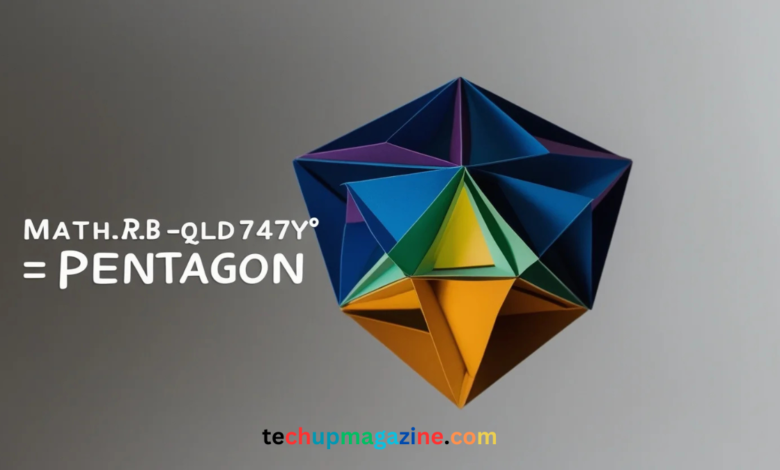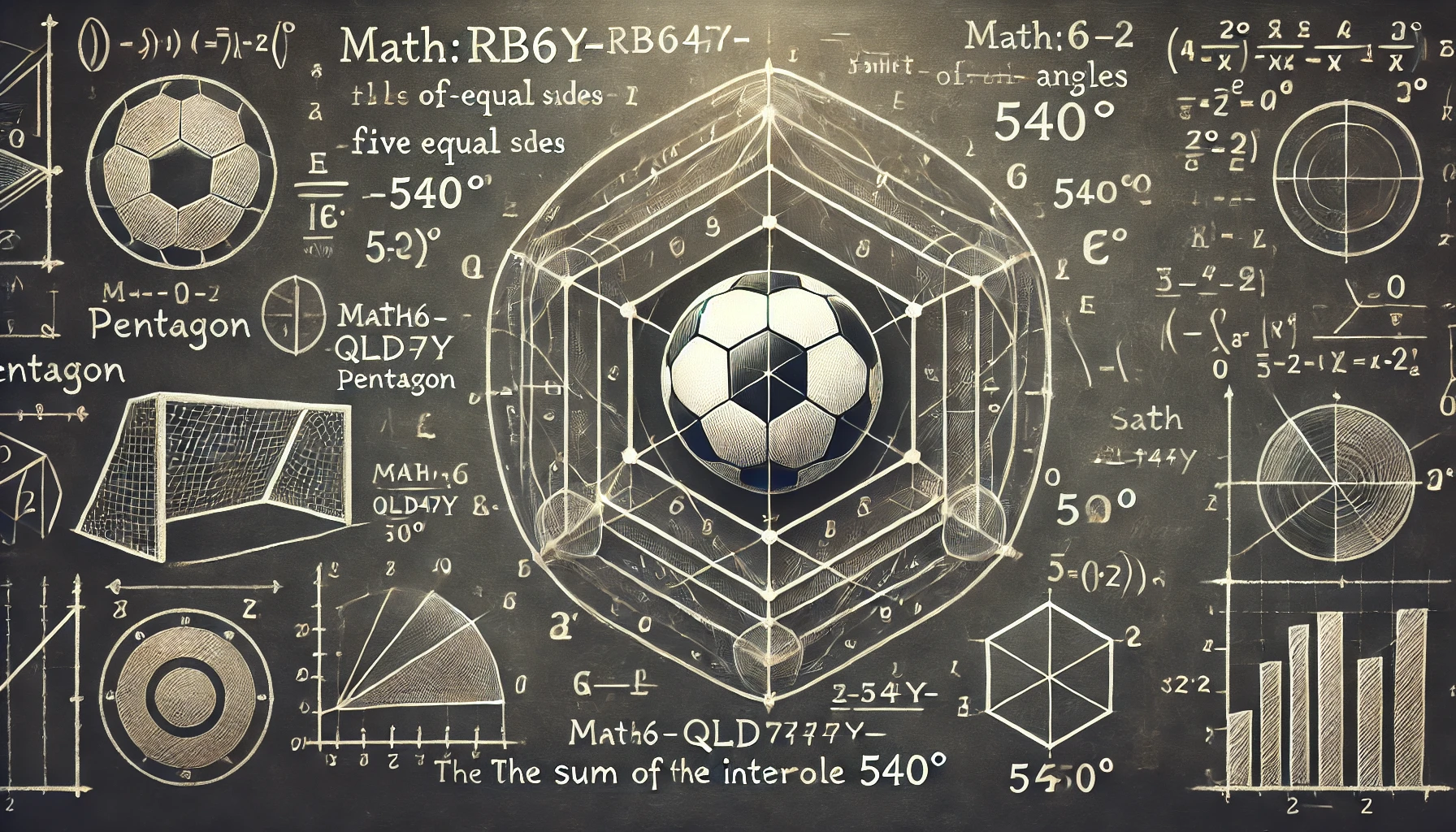Exploring the Fascinating World of Geometry with “math:rb6-qld747y= pentagon

Introduction to the Geometry of the math:rb6-qld747y= pentagon
math:rb6-qld747y= pentagon When we think of shapes in mathematics, the pentagon stands out for its unique five-sided structure and the range of properties it holds. The pentagon isn’t just a shape but a gateway to exploring various mathematical principles and geometric applications. This article will dive into all aspects of the pentagon, exploring its properties, types, and applications, while uncovering its historical and mathematical significance. The study of pentagons encompasses everything from basic geometry to complex applications, making it an intriguing subject for learners and experts alike math:rb6-qld747y= pentagon.
The Basic Properties of a math:rb6-qld747y= pentagon

math:rb6-qld747y= pentagon are fascinating geometric shapes that naturally occur in various aspects of nature, art, and design. A pentagon has five sides, five vertices, and five angles, which makes it distinct from shapes with fewer or more sides. These sides and angles contribute to the many interesting properties that make pentagons both simple and complex math:rb6-qld747y= pentagon.
In a regular pentagon, all sides are equal, and each interior angle is identical. The structure of a regular pentagon provides it with symmetry, making it pleasing to the eye and stable in design. On the other hand, irregular pentagons do not have equal sides or angles, offering more variability and complexity. The study of pentagons typically begins with these basic properties before moving into more specialized applications math:rb6-qld747y= pentagon.
Types of Pentagons and Their Unique Characteristics
When we talk about pentagons, it’s essential to differentiate between regular and irregular pentagons. A regular pentagon is what most people visualize when they think of this shape. This type has all sides and angles equal, making it symmetrical. Regular pentagons are common in mathematics and are frequently used in architectural designs due to their balanced appearance math:rb6-qld747y= pentagon.
Irregular pentagons, however, have sides and angles that are not equal, leading to a variety of shapes within the pentagon family. Some irregular pentagons are convex, meaning all vertices point outward, while others are concave, with at least one vertex pointing inward. The irregular pentagon’s flexibility allows it to appear in many forms, each with distinct properties and applications math:rb6-qld747y= pentagon.
Understanding the Interior and Exterior Angles of a Pentagon
The angles in a pentagon are crucial to understanding its geometry. In a regular pentagon, each interior angle is the same, which adds a level of consistency to the shape. The total sum of the interior angles of a pentagon is derived using a general formula applicable to all math:rb6-qld747y= pentagon.
The exterior angles of a pentagon, like other polygons, sum up to a fixed degree, providing a fascinating symmetry to the pentagon’s geometry. These properties of angles in pentagons make them easy to identify and study in complex geometric problems, as well as in practical design math:rb6-qld747y= pentagon.
Pentagon Symmetry and Its Importance in Geometry
Symmetry is a significant aspect of geometry, and the pentagon is no exception. Regular pentagons exhibit rotational and reflective symmetry, allowing them to maintain their shape even when rotated or reflected. This symmetry is not just mathematically interesting but also practically useful in various design and engineering applications math:rb6-qld747y= pentagon.
Reflective symmetry in pentagons means that if you draw a line through specific points, the two halves of the shape will mirror each other. Rotational symmetry allows the pentagon to be rotated around its center, aligning with its original shape at various angles. Symmetry in pentagons has implications in fields like art, architecture, and even molecular biology math:rb6-qld747y= pentagon.
Practical Applications of Pentagons in Design and Architecture
The practical applications of pentagons are extensive, especially in design and architecture. The symmetry and stability of the regular pentagon make it a favorite in creating stable structures. From buildings to furniture, pentagons provide an aesthetic appeal that’s both unique and structurally sound math:rb6-qld747y= pentagon.
In architectural design, pentagons are used to create floor plans and wall designs. The five-sided shape offers a visually appealing alternative to standard shapes like squares and rectangles. Many famous buildings incorporate pentagonal elements, adding both style and durability. Pentagons also appear in nature, in objects like flowers and starfish, which further inspires architects and designers math:rb6-qld747y= pentagon.
The Role of Pentagons in Mathematics and Geometry Studies
In mathematics, pentagons are essential in the study of polygons and geometry. They introduce learners to more complex shapes beyond triangles and squares, encouraging critical thinking and spatial understanding. Through the study of pentagons, students learn about symmetry, angles, and polygon properties, building a foundation for more advanced mathematical concepts math:rb6-qld747y= pentagon.
Geometrically, pentagons are often used in problem-solving exercises that involve spatial reasoning. The complexity of irregular pentagons also adds an element of challenge, helping students develop problem-solving skills. In higher mathematics, pentagons play a role in understanding tessellations and three-dimensional shapes, offering students a comprehensive view of geometric structures.
Natural Occurrences of Pentagons in the World Around Us
Pentagons are not just theoretical shapes; they are present all around us. In nature, pentagonal patterns are seen in flowers, fruits, and even in the molecular structure of certain compounds. These natural occurrences inspire the study of pentagons in mathematics and show the connection between geometry and the world.
One notable example is the shape of certain flowers, like morning glories, which often have a pentagonal structure. In biology, the pentagon shape is also present in molecules, influencing their properties and interactions. This natural occurrence of pentagons demonstrates the significance of geometry in both natural and scientific studies.
Exploring Pentagon-Based Tessellations and Patterns
Tessellations are patterns created by repeating a shape without gaps or overlaps, and while pentagons don’t tessellate naturally like squares or triangles, they can still be used to create intricate patterns. In art, pentagonal tessellations are used to create mosaic-like patterns, offering unique visual effects and inspiring creativity.
In mathematics, the study of tessellations with pentagons involves exploring how these shapes can fit together under certain conditions. Irregular pentagons, for instance, can tessellate if arranged correctly, adding a level of complexity to geometric studies. Artists and mathematicians alike find pentagonal tessellations fascinating for their blend of structure and flexibility.
Pentagons in Art and Culture
Pentagons have found their way into various forms of art and cultural symbolism. In different cultures, the five-sided figure has been used to represent concepts like harmony and balance, likely due to its symmetry and unique structure. This symbolic significance gives the pentagon a place in visual art, religious symbols, and cultural designs.
Art inspired by pentagons can be seen in ancient mosaics, architecture, and even modern abstract art. The shape’s ability to convey balance and stability makes it a popular choice in visual arts. Beyond aesthetics, the pentagon also appears in religious and spiritual symbols, showing its cultural importance.
The Mathematical Exploration of Pentagon Formulas and Theorems
Understanding the mathematical formulas related to pentagons is essential for comprehending their properties fully. The calculations for interior and exterior angles, side lengths, and areas of pentagons are part of this study. In particular, formulas involving regular pentagons offer a straightforward way to calculate these properties due to the shape’s consistent angles and sides.
Mathematicians have developed various theorems related to pentagons, exploring their place in geometry and algebra. The study of these theorems helps learners understand how pentagons relate to other polygons and offers insight into the complexity of geometric shapes.
Advanced Applications of Pentagons in Engineering and Technology
In engineering and technology, pentagons are valuable due to their unique geometric properties. The shape’s stability and symmetry make it a popular choice in constructing durable structures and designing various mechanical parts. Engineers often employ pentagonal shapes in the development of machines, buildings, and even spacecraft, where stability is crucial.
The use of pentagons in technology also extends to software design, where pentagon-based algorithms can improve data structures and graphical representations. This innovative application of pentagons highlights their versatility and impact in modern science and engineering.
Why Study Pentagons? The Importance of Understanding Complex Geometric Shapes
Studying pentagons is not just about learning a five-sided shape; it’s about understanding the complexity and beauty of geometry. The pentagon challenges learners to think critically about angles, symmetry, and properties that apply to various polygons. By studying pentagons, students build foundational skills that apply to higher mathematics, engineering, and even art.
Beyond academia, the pentagon’s presence in nature, design, and technology shows its real-world relevance. From basic geometry to complex engineering applications, the study of pentagons exemplifies how a simple shape can have diverse implications across multiple fields. The pentagon, therefore, is more than just a shape; it’s a bridge to understanding the vast and intricate world of geometry.
This article provides an in-depth look into the world of pentagons, illustrating how this five-sided shape holds mathematical, practical, and cultural significance. Whether in nature, design, or advanced mathematics, pentagons remain a vital part of geometry and a subject worthy of exploration.




